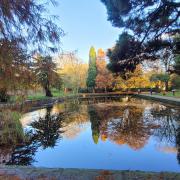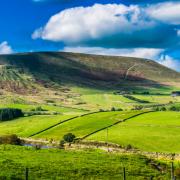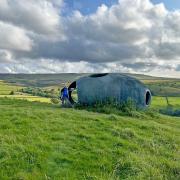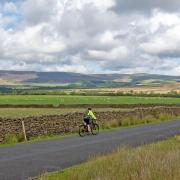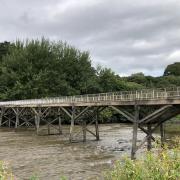Keith Carter strides out from Buttermere on a walk which circles Crummock Water
IN order to research this walk my wife and I treated ourselves to a two-night break at a renowned B&B overlooking Crummock Water, Wood House owned by the National Trust but run impeccably by Mike and Judy Mackenzie. The guests around the breakfast table were all walkers but what a diversity!
For one couple, Cat Bells seemed like an unattainable goal; for a single lady of the Third Age, the trip up Haystacks would take all day; for two young, fit Southerners, the round of the Buttermere Fells was their aim including at least three mountains over 2,000 feet.
This area of the North West Lakes offers a wide choice of walks for all abilities and it would take weeks to complete them all. My chosen walk is one that avoids the high tops yet presents a decent challenge and a great day on foot, whatever your level. It has no bail-out clause, busesbetween Buttermere and Cockermouth being a rarity and, as far as I can discover, needing to be booked in advance.
We started from Buttermere village where it is possible to park although the spaces get filled up quickly on summer weekends as you would expect in a remote Lakeland valley.
Walk to the left of the Fish Hotel on a clear track which does a left then a right before heading dead straight until it meets the stream known as Buttermere Dubs. Cross this by the old packhorse bridge and turn right then go through a gate and pick your way on a stony path with the expanse of Crummock Water opening up to the right. Our aim is tokeep up so at a fork start climbing on a diagonal path across the fell, soon crossing a footbridge.
The area to be crossed is quite boggy and after a wet summer it had not dried out in spite of a warm spell in early September. We certainly had to watch where we put our feet. Another hazard soon presented itself – a herd of Belted Galloway cattle had occupied the fell and the bullsat astride the path with a look of disdain on his somnolent face. A detour was necessary with the cautionary advice to my wife not under any circumstances to meet his eye and by this means we escaped unscathed. Never look them in the eye.
Maintain height and contour and soon the boggy ground gives way to a drier path through gorse and bracken before rising to a crest. As we continue proceeding above a gully to our right we come to a wall with a gate which we go through, the path crossing the beck by a footbridge. To the left can be seen the waterfall of Scale Force, at 170ft the highest in the Lake District, a spectacular sight in spate and only accessible on foot.
After crossing the footbridge turn down right through bracken and continue down towards the lake as far as a circular sheepfold where the path divides: right to go back to Buttermere, left to continue our circuit of the lake. The lakeside path has been restored in places although I wouldsay there is still more work to be done. Perhaps they could ship in those huge flagstones from derelict mills in Lancashire and Yorkshire. It would certainly help.
As the end of the lake comes in to sight we can see the path coming to a wall that runs down to the lake. A gate at the water’s edge leads on to a shingle beach much visited by sheep. Follow the shore round the end of the lake passing an ornate pump house enclosed within railings.
Crummock Water was opened in 1903 to provide drinking water for Workington and Whitehaven. If you want to launch a small boat on the lake you need to get a permit from the National Trust. So there is very little boating such as you might see on Windermere and Coniston Water.The River Cocker flows out of the lake and we cross it by a footbridge from where we can see a fish ladder and weir.
Keep to the path to enter Lanthwaite Woods with old pines much in evidence and soon a boat-house is passed. It would be hard to get lost here provided that you keep to the lake side, the water on our right. The path’s momentum is interrupted by a wall and we have to turn up the bank on the left to meet the road at a kissing-gate.
Turn right on the verge and we come to a parking area, Cinderdale Common, much frequented by folks out for the day including those who like to park up and doze in the car or get the folding chairs out and sit by the open boot of their car inhaling the fumes of passing traffic. Cross theparking area and keep ahead on a grassy track with the wall to the right.
This path has been used by wheeled transport in the past but is now grassed over. It leads away from the road into Rannerdale or Rannadale, an area known for bluebells in the spring. Continue on this path as far as a footbridge, cross it and turn down right, following the stream down tothe road. At one point the word PATH has been helpfully daubed on a rock, keeping us on the straight and narrow.
On reaching the road, keep left for 70 yards then leave the road and climb the rake to the viewpoint from where JMW Turner painted his famous view of Buttermere. What a fabulous outlook! The path descends the slope down to the road which we reach at a stand of Scots pine opposite a small lay-by. Cross the road and go down steps through a gate to the lake shore.
After a grassy sward ideal for picnics by the water’s edge the path cuts inland through scattered woodland known as a haunt for red squirrels. We saw one, surprisingly dark in colour, more chestnut than red. Followthe path that skirts Mill Beck and leads to Buttermere village past Syke Side camp site to the back of the Fish Hotel. If the Fish is closed, try the Bridge Hotel which is notable for two things: beers from Hawkshead Brewery on draught and a pet hen.
Our fellow guest at Wood House ‘did’ Haystacks, to her credit, or as she said, Haystacks did her!
See you on the hill.
INFORMATION
Distance: Just under nine miles.
Time to allow: 4 � -5 hours
Start and finish: Buttermere village
Refreshments: Only in Buttermere, none round Crummock Water.
Map: OS Explorer OL4 The English Lakes North West.
Useful book: A Walk around the Lakes by Hunter Davies
Public Transport: The Honister Rambler links Buttermere with Keswick, four a day via Honister Pass and Borrowdale and four via Braithwaite.















